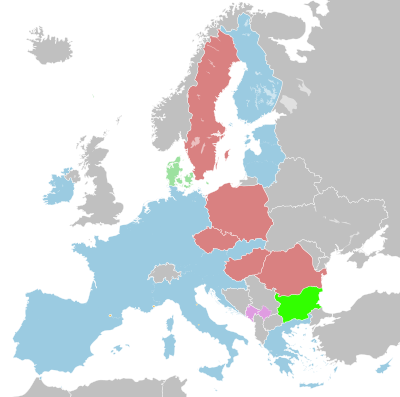
Back توسيع منطقة اليورو Arabic Ampliación de la zona del euru AST Ampliació de l'eurozona Catalan Přijetí eura Czech Διεύρυνση της ευρωζώνης Greek Ampliación de la eurozona Spanish Euroala laienemine Estonian Élargissement de la zone euro French Allargamento della zona euro Italian ევროზონის გაფართოება Georgian
The enlargement of the eurozone is an ongoing process within the European Union (EU). All member states of the European Union, except Denmark which negotiated an opt-out from the provisions, are obliged to adopt the euro as their sole currency once they meet the criteria, which include: complying with the debt and deficit criteria outlined by the Stability and Growth Pact, keeping inflation and long-term governmental interest rates below certain reference values, stabilising their currency's exchange rate versus the euro by participating in the European Exchange Rate Mechanism (ERM II), and ensuring that their national laws comply with the ECB statute, ESCB statute and articles 130+131 of the Treaty on the Functioning of the European Union. The obligation for EU member states to adopt the euro was first outlined by article 109.1j of the Maastricht Treaty of 1992, which became binding on all new member states by the terms of their treaties of accession.
As of 2024[update], there are 20 EU member states in the eurozone, of which the first 11 (Austria, Belgium, Finland, France, Germany, Ireland, Italy, Luxembourg, the Netherlands, Portugal and Spain) introduced the euro on 1 January 1999 when it was electronic only. Greece joined 1 January 2001, one year before the physical euro coins and notes replaced the old national currencies in the eurozone. Subsequently, the following eight countries also joined the eurozone on 1 January in the mentioned year: Slovenia (2007), Cyprus (2008), Malta (2008), Slovakia (2009),[1] Estonia (2011),[2] Latvia (2014),[3] Lithuania (2015) and Croatia (2023).[4]
Six remaining states are bound by the EU treaties to introduce the euro once they fulfill certain economic criteria known as the convergence criteria — Bulgaria, Czech Republic, Hungary, Poland, Romania and Sweden — of which only Bulgaria participate in ERM II.[5] Since the convergence criteria require participation in ERM II for a minimum of two years, and non-eurozone member states are responsible for deciding when to join ERM II, they can delay their compliance with the criteria by not joining ERM II.
All non-eurozone member states are assessed for compliance with the convergence criteria by the ECB and the European Commission biennially, with the next report planned to be published in June 2024. Member states can also request that their compliance be evaluated outside this two-year cycle as of any month of their choosing, as compliance is subject to change throughout the year.[6]
Denmark has a treaty opt-out from the obligation to join the eurozone even if it complies with all criteria; historically this also applied for the United Kingdom, until it left the EU on 31 January 2020.
- ^ Kubosova, Lucia (5 May 2008). "Slovakia confirmed as ready for Euro". euobserver.com. Retrieved 25 January 2009.
- ^ "Ministers offer Estonia entry to eurozone January 1". France24.com. 8 June 2010. Retrieved 26 April 2011.
- ^ "Latvia becomes the 18th Member State to adopt the euro". European Commission. 31 December 2013. Retrieved 31 December 2013.
- ^ Wesel, Barbara (1 January 2023). "EU member Croatia joins the eurozone". Deutsche Welle. Retrieved 2 January 2023.
- ^ "Bulgaria, Croatia take vital step to joining euro". Reuters. 10 July 2020.
- ^ "Convergence Report". European Central Bank. Retrieved 2 March 2024.
